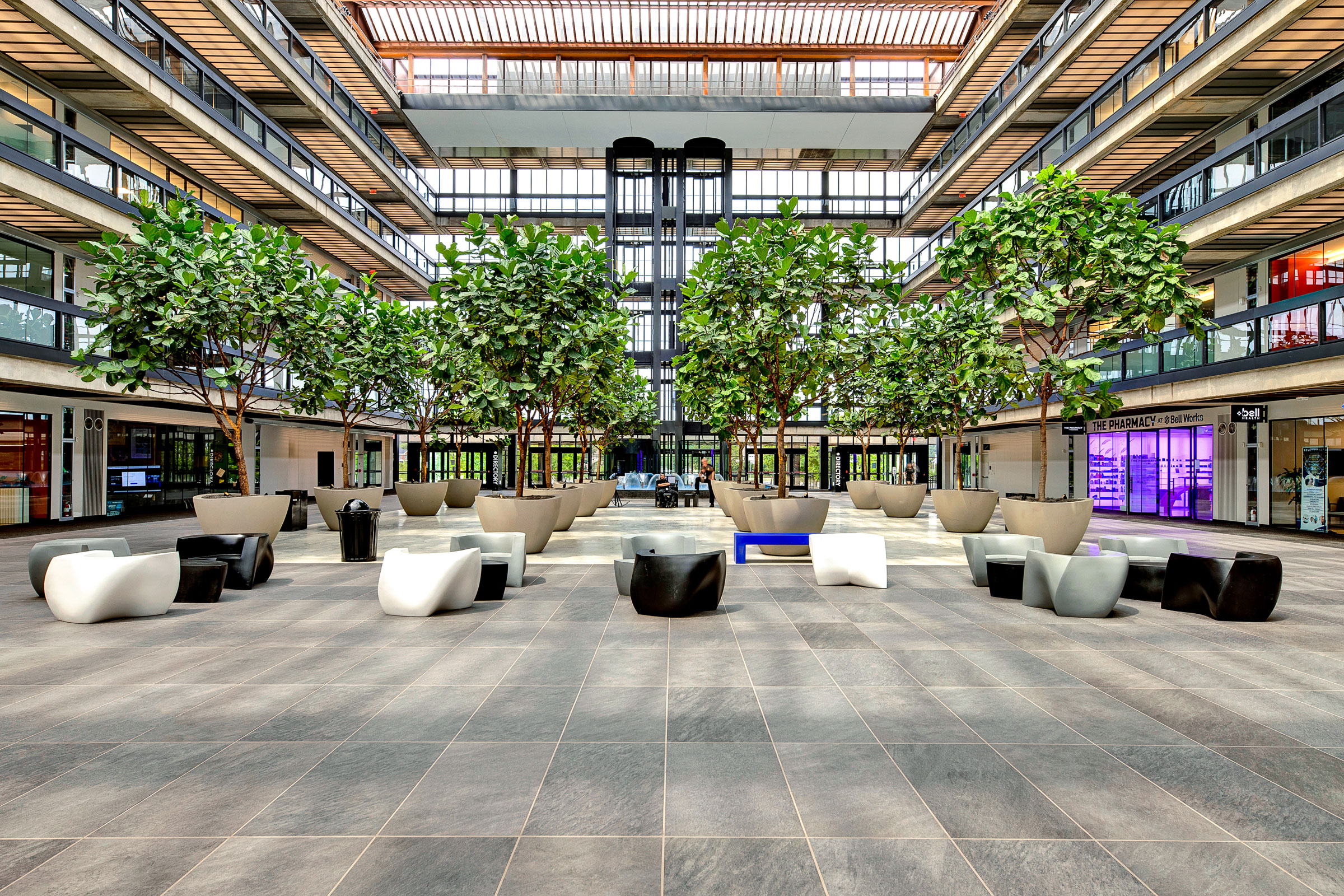Story at a glance:
- The historic Bell Labs building in Holmdel, New Jersey is now a hub for business, retail, and more known as Bell Works.
- Bell Works features open spaces with ample natural light thanks to a glass facade.
- Ambius installed 32 fiddle-leaf fig trees in the building’s expansive atrium.
Bell Works in Holmdel, New Jersey is a reimagining of the historic Bell Labs building originally designed by Eero Saarinen in 1958. Today the building is a destination for business and culture, complete with traditional offices, retail, dining, and more.
The Bell Works building stands out against its suburban backdrop—the two-million-square-foot building features a mirrored facade that reflects the sky in every direction. The building’s distinctive glass ceiling features 3,000 panes of photovoltaic glass that generate 20% of the complex’s power for common areas and car charging stations.
Bell Works’ embrace of sustainability goes beyond the building’s ceiling, though. As the historic building continues to evolve, companies like Ambius have helped Bell Works create interior green spaces. Ambius worked closely with the creative director of Bell Works, Paola Zamudio, to install a collection of fiddle-leaf fig trees in the building’s open atrium.
Bell Labs History
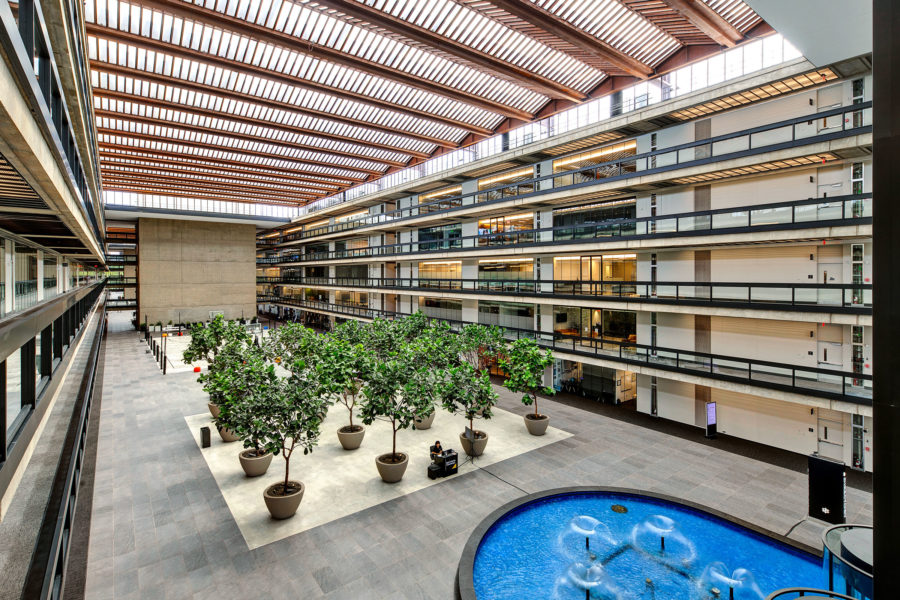
“When I was doing my research on mid-century modernism, I noticed fiddle-leaf figs were a big trend during that time. Now that trend has come back,” says Zamudio. She says they made a great decision in working with Ambius and choosing the classic plant. Photo courtesy of Bell Works
Previously a research and development facility for AT&T, the building was constructed between 1959 and 1962. From 1962 to 2007 the Bell Labs building housed more than 6,000 scientists and researchers covering everything from the Big Bang Theory to cellular technology.
It was a time when long work hours were interrupted by cigarette breaks and walks across the expansive building. The walks, at least, remain. “One thing about the Bell Works buildings is that they are built in a horizontal way, not vertical,” Zamudio says. “This helps in the distribution of things and creates a street-block feel … Because when you go into a building like the Empire State Building you go to a high floor, but you never cross paths with people.”
Zamudio says buildings like these give ample opportunity for connection. “There is a lot of opportunity for walking around and chances for serendipitous moments. And I think that’s a good thing.”
Inside the Atrium
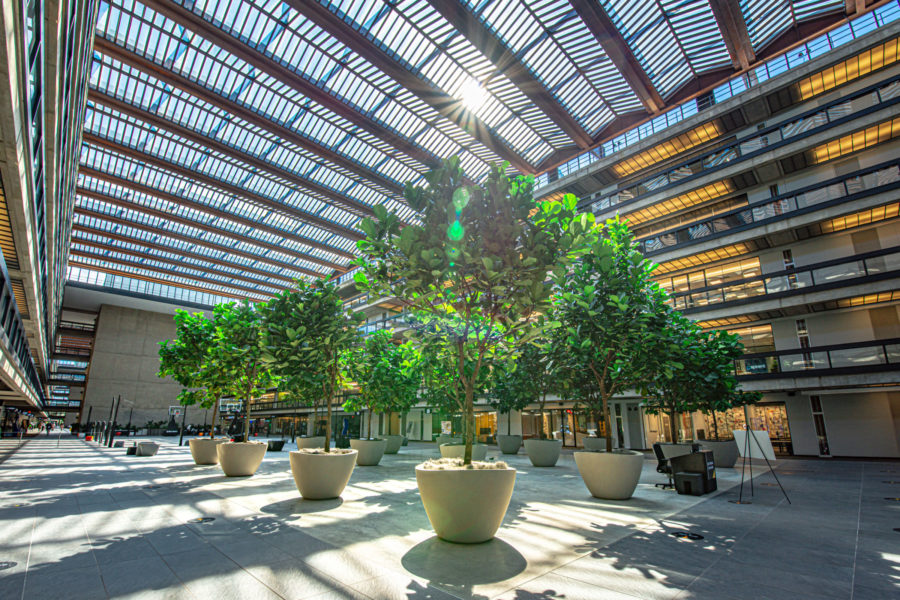
Zamudio chose the fiddle-leaf fig tree because of its air detoxifying properties. These trees now stand tall on The Block at Bell Works for tenants and visitors to enjoy daily. Photo courtesy of Bell Works
To bring even more life to the project, Ambius installed 32 fiddle-leaf fig trees ranging from 18 to 22 feet high. The trees serve as a focal point and provide a park-like stroll through the building’s sun-soaked atrium. “The goal was to bring the outside inside because the building was a Saarinen building from the 1960s and he was known for wanting the interior to have a connection to the exterior,” Zamudio says. “For me as a designer and being in charge of giving life to this building, it was important to follow that route Saarinen set.”
The Bell Works and Ambius teams traveled to Florida to hand-pick each tree for the project. Zamudio knew how detail-orientated the Bell Works team was, with the owner also joining the teams in Florida. She points out how Ambius made the trip a collaborative effort and ensured each plant was healthy.
Zamudio also appreciates the way plants make a space feel. “With this building that is all concrete and steel, I knew the way to soften the space and make it more organic and warm was to bring in greenery. So that was my mission,” she says.
Incorporating plants into an indoor space is not always easy—especially when using plants native to tropical environments. “The challenge was getting the trees to acclimate because they came from Florida. It took time and we saw many leaves lost in the beginning,” Zamudio says. “But with Ambius’ continued maintenance and time, the trees have been thriving. We get great feedback from the tenants in the building. They love how fresh the air is.”
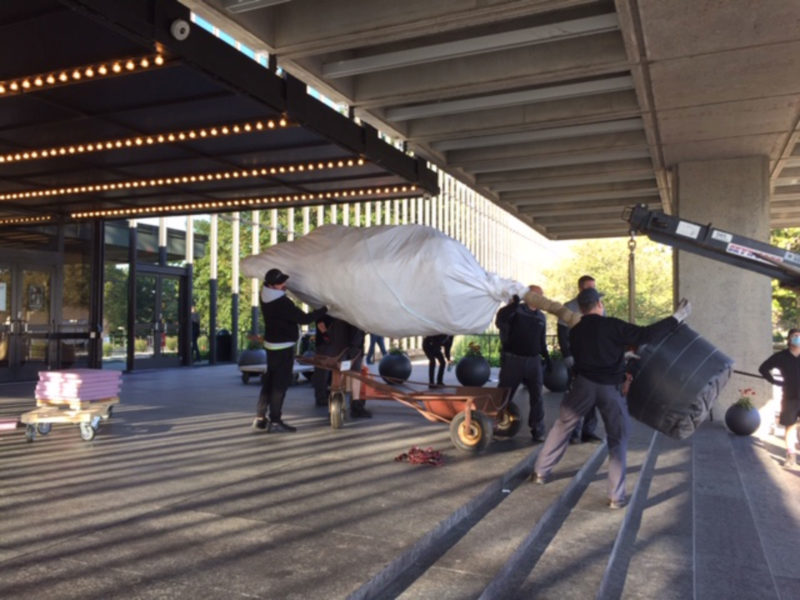
Ambius faced the challenge of having no formal loading dock at Bell Works. Pictured here are installers climbing 14 feet of stairs with the fiddle-leaf figs in hand. Photo courtesy of Ambius
Ambius worked to overcome other challenges on the project as well—like how to get plants in without a formal loading dock. The 32 trees had to be hoisted 14 feet prior to being brought into the building. The installation team guided the movement of each tree as many were approximately 20 feet tall and 7 feet wide. “The team had to climb the 14 feet of stairs while making sure each tree cleared the overhead awning of the building,” says Cassy Vitale, Ambius’ New Jersey operations manager.
One of the biggest challenges was creating a plan for how to irrigate the trees, as the containers for each plant were not set up with a system capable of sustaining the trees over time. The team devised an irrigation and stabilization plan for the containers. “We wanted these trees to be on a sub-irrigation system, as there is electricity running through the containers for up-lighting on the trees,” Vitale says. “The sub-irrigation keeps the water contained in a reservoir, so the plant takes the water up directly from the bottom instead of top watering and potentially hitting any wiring.”
Despite installation and irrigation challenges, the fiddle-leaf fig trees have been an important addition to Bell Works.
As a creative director and trend forecaster, Zamudio knows that the trend of biophilic design is nothing new, but it’s become more important than ever with the need for clean air in the built environment. “Having installed the trees when we did, I think it was the perfect moment to do so because we get the best feedback. People love the trees; it was one of the best additions from a design perspective. I think plants make the best decor—and they never go out of style.”
Continued Plant Care
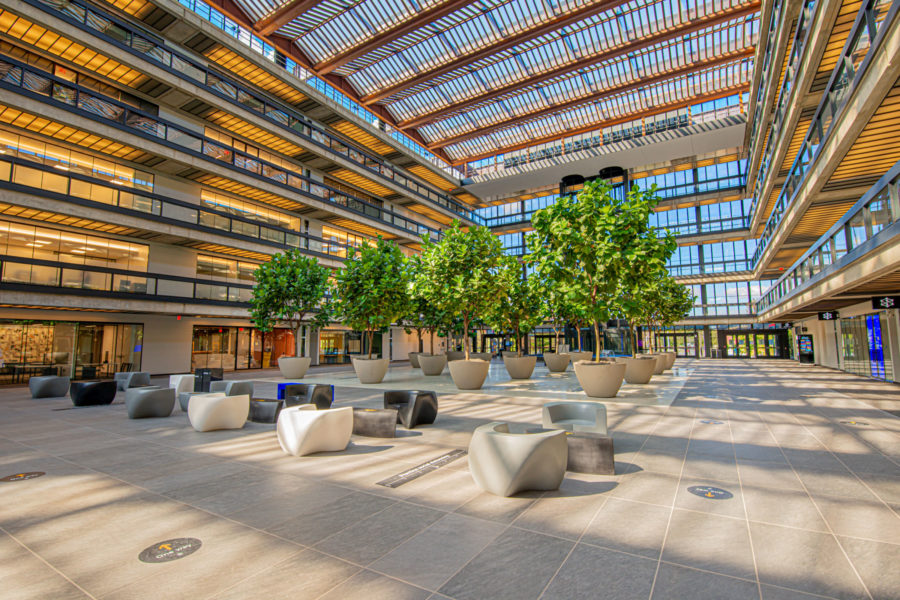
Zamudio placed 16 fiddle-leaf fig trees in the East Atrium and 16 in the West Atrium at Bell Works—each standing 25 feet tall. Her intent was to bring the outside in, which was a key objective when the historic building’s original architect, Eero Saarinen, was designing Bell Labs. Photo courtesy of Bell Works
One perk of working with a company like Ambius is that they maintain their installations even after the project has been completed. “Ambius plant care specialists handle maintenance care as well, so Bell Works does not have to worry about maintaining the plants,” Vitale says. “The plant care specialists fertilize the plants weekly as well as use telescopic dusters to dust and remove spent leaves. The specialists keep a log of each tree, including moisture level in the soil, as well as the amount of water added to the sub-irrigation per tree weekly.”
Ambius also takes care in assessing a space and figuring out what plants will thrive. The fiddle-leaf fig installation at Bell Works was no different. Zamudio gathered a list of potential plants for the space and Ambius was able to assist in choosing the right species by conducting a light study.
Ambius’ plant care specialists will use a systemic pesticide when needed that is absorbed through the root system and dispersed throughout the tree so there is no need to spray an insecticidal soap. This benefits the Bell Works building as it’s a public space with concrete floors.
The collaboration with Ambius and Bell Works continues as the plants are cared for on a weekly basis. Zamudio is grateful for how the installation turned out. “I think the most rewarding part is seeing the trees in the space,” she says. “I had a vision in my mind and once I saw them installed and saw them from all angles—because that’s the benefit of the Bell Works building—I thought ‘Wow, it does make a difference.’ The contrast and life that the trees bring to the space is amazing.”
The Benefits
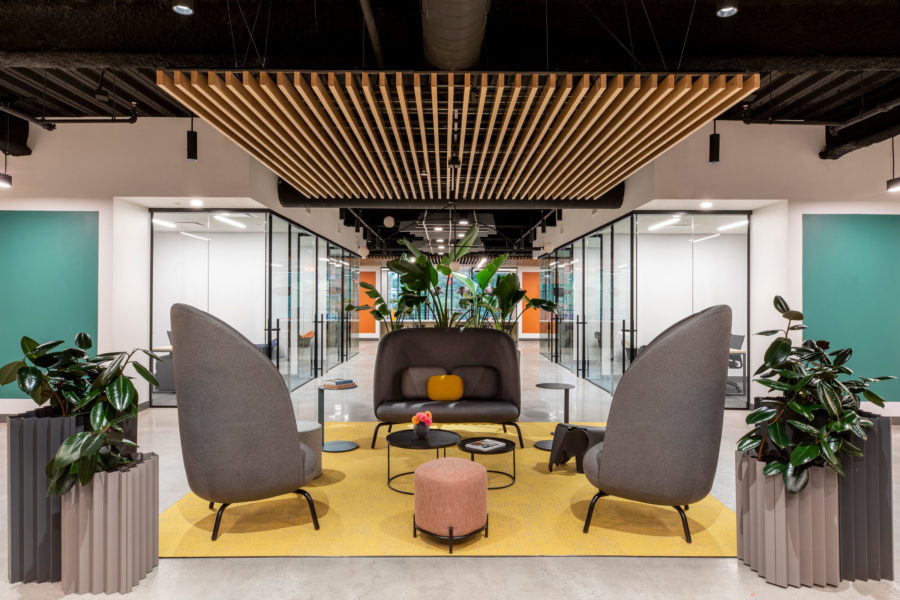
Biophilic design plays a key role in the Bell Works’ coworking space, coLab. Zamudio used greenery strategically to enhance the space with clean air and private vignettes for members to feel comfortable at the workplace. Photo courtesy of Bell Works
The benefits of plants in indoor spaces form a long list. Plants help cleanse the air of harmful VOCs and make people happier. A 2015 study indicated that indoor plants can also reduce physiological and psychological stress.
Designers like Zamudio know that interior spaces are only going to get greener. “I think trees and plants are going to be in the built space forever. For me it makes such a difference to have living things in a space,” she says.
Buildings that focus on implementing greenery like Bell Works can be a blueprint for the future of office and coworking spaces. Zamudio knows a lot of us can work from anywhere, but she says that gets boring.
“It’s good to go somewhere and change up your scenery, but you don’t want to just go to any place because the office is changing. It’s important for me to think about what is the office of the future. How is it changing and how do we design it? What are the right furnishings? What are the right collaborative spaces? How do we make it inviting? So that is what we are trying to do at Bell Works.”

